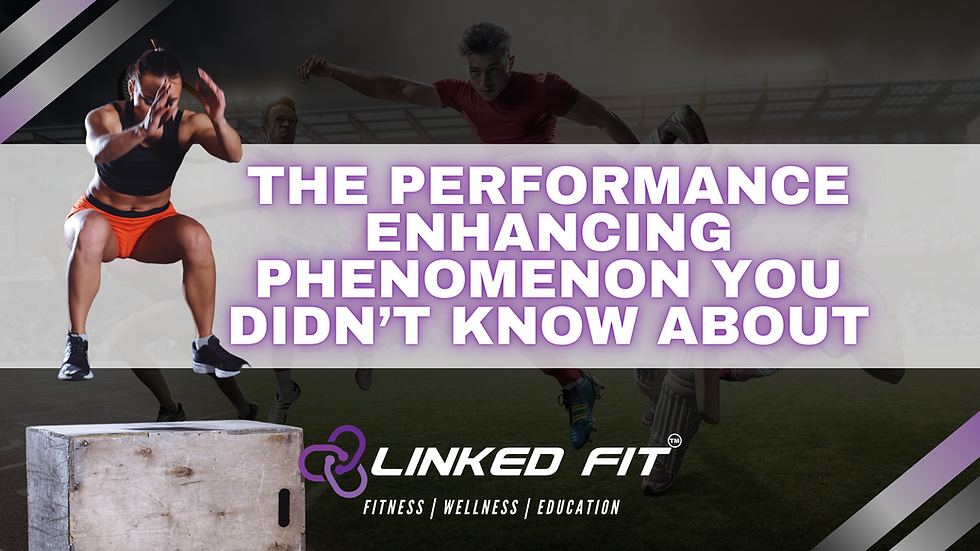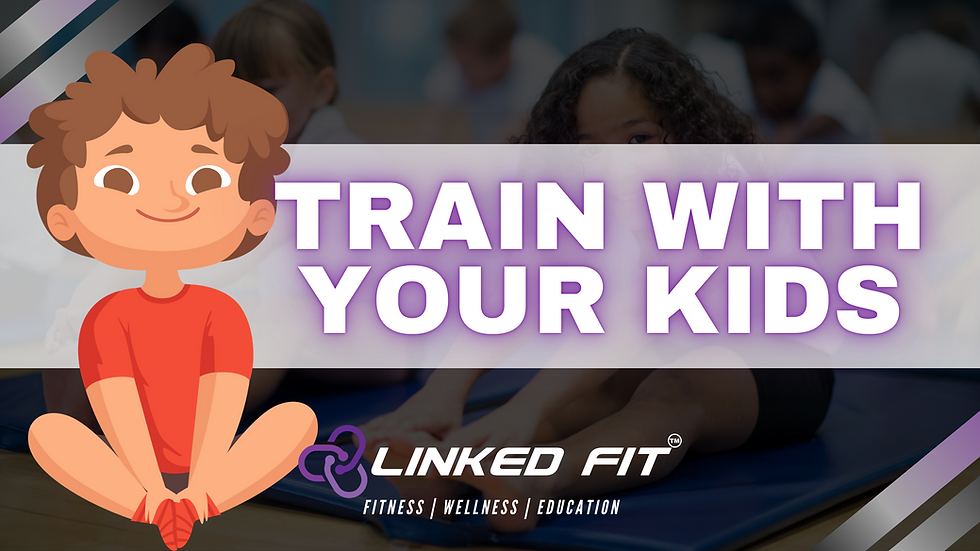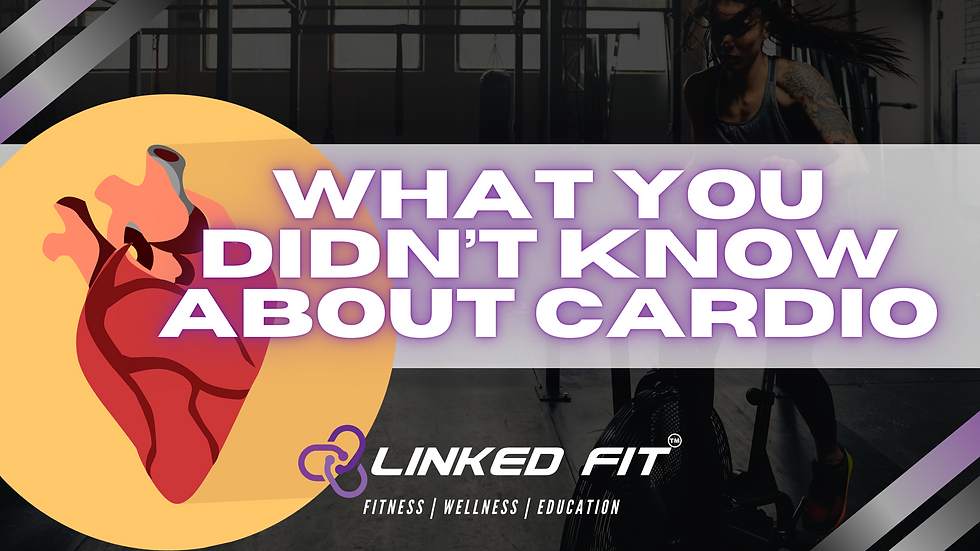Recovery Cycle
- Linked Fit

- Sep 15, 2020
- 11 min read
Updated: Aug 27, 2022

This article is focused on the five components we consider to be the most influential on the recovery process during an active lifestyle in training and sport.
In any training routine, an individual accumulates fatigue that induces physiological and psychological demands that can reduce performance capacities (Skorski et al., 2019). Training fatigue isn’t just the fatigue experienced during weightlifting, practice, or other strength and conditioning strategies but the additional things we do in life.
Recovery is a powerful tool when it is used correctly! - Dr. Dane Bartz

Let’s take an accountant who lives a stressful life at work. They love what they do, but each day adds up and provides a sense of weight on their shoulders, and it continues to build! Now let’s move toward the professional athlete who may travel regularly and doesn’t have the complete opportunity to spend time with their family as they wish. Two different types of individuals experience life from two different lenses!


Recovery Clock
At Linked Fit, we strive to build strong relationships during recovery. Each individual may need different focuses to optimize their investment return towards their mind, body, and spirit! These focuses will help bring attention to a specific component of one’s life: health considerations, stress, nutrition, sleep, or training.
What does your Recovery Clock tell you?

The Recovery Cycle values the movements of the time and how it greatly impacts our desired adaptation. The movement of time needs to be structured and organized in a manner that becomes complete with the removal of incomplete patterns. In simple terms, what time does your Recovery Clock say? There is an hour hand, minute hand, and second hand with a standard clock. The Recovery Clock utilizes the same structures! The hour hand is the primary line of defense. This needs to be the primary focus for restoring homeostasis via recovery cycle standards. The minute hand is the secondary line of defense and should be the second line for optimizing recovery. The second hand is unique since it’s a continuous revolution and changes “every second.” Our lives continuously change, and each component of the recovery cycle needs adjustments to keep moving forward. Each component should always be retained and never forgotten to restore our bodies from the precisions of life.
It’s important to consider the advantages of each component within the recovery cycle, as they all add significant value towards the greater good of regeneration of physiological and psychological parameters. Next, this article will deliver a general overview of each component and how one can relate it to the benefits of an active lifestyle.
Health
Health should be the priority when developing any program for a client or yourself! Health comes in all different areas… cardiovascular health, immunity, orthopedics, reproductive system, neurology, and many more! As many would state in the medical field, getting an annual physical with your primary care physician is important. These physicals are a great way to stay on track for any medical concerns or issues that might spike interest.
It’s widely known that high blood pressure is a killer among many individuals annually. In 2014, the annual cost for treatment of high blood pressure was $53.2 billion (Loucks et al., 2019), and it affects up to 40% of adults worldwide, with the prevalence continuously increasing (Kim, Choi, Bae, Kim, & Ma, 2019). Hypertension has become one of the world's non-communicable diseases to prevent and treat (Loucks et al., 2019). Although it might not be the generally increased blood pressure via one incident, it can become an issue over time, and the prognosis can be worrisome. Therefore, attention is needed to the cardiovascular system if issues are noticed.

Our bodies need a strong immune system to fight viruses, infections, and bacteria. Unfortunately, we live lives that include foreign invaders trying to enter our bodies and harm us. The white blood cells protect the body from these invaders and provide a defense mechanism when they are called to work. The immune system is comprised of both a fast (innate) and slow (adaptive) response team (Calder, Carr, Gombart, & Eggersdorfer, 2020). The innate immune system is the physical barrier that prevents pathogen entry, such as the skin, which recognizes the presence of pathogens (Calder et al., 2020). The innate system is known to move quickly to recognize and destroy threats, typically through an inflammatory process (Calder et al., 2020). The adaptive immune system is responsible for generating immunological memory that will produce a vigorous, fast response to a repeated pathogen threat (Calder et al., 2020). Therefore, health needs to prioritize immunity upon fast and slow-acting responses for optimal health and recovery.
Currently, our world deals with significant pain and functional limitations in the general population due to common orthopedic issues (Cleveland, Nelson, & Callahan, 2019). These common orthopedic issues are associated with disability, pain, and commodities (Cleveland et al., 2019). In the US, about 13% of men and 19% of women will be diagnosed with knee osteoarthritis, and over half will receive a total knee replacement (Beswick, Dennis, Gooberman-Hill, Blom, & Wylde, 2019). As individuals focus on the components of the recovery cycle, health may direct us towards our potential orthopedics dysfunctions that need attention.
“What’s the difference between recovery & healing?”

It’s important to understand that recovery shouldn’t get confused with healing. In many cases, recovery gets used in replacement for healing from an injury. At Linked Fit, our system defines these two words differently in recovering from an active lifestyle or athletic event. Healing is the process of becoming healthy again through treatments, while recovery is returning to a normal state of health, mind, and strength. Therefore, let’s not get these two words confused with each other and stay focused on the recovery for optimal health concerns.
Stress
How do you manage stress?
Powerful research has shown that stress significantly influences health extensions (Zaman et al., 2019). The body is known to significantly reduce physiological reserves due to internal and external stressors (Pansarasa et al., 2019). When physiological operations decline, the body losses the ability to return to homeostasis in multiple systems with increased fatigue, poor muscular strength, and regenerating cells from accumulated damage (Pansarasa et al., 2019). The psychological influence of stress highly impacts the reorientation of an individual’s cognitive and physiological capacities, thus leading to an imbalanced return to homeostasis (Anderson, Di Nota, Metz, & Andersen, 2019).

Unfamiliar, unexpected, or unpredictable situations are generally more stressful and likely associated with stronger physiological destruction (Anderson et al., 2019). Most individuals are unprepared for these stressful situations and may experience spikes in autonomic activation via sympathetic dominance. The recovery cycle values the importance of returning the body to homeostasis after experiencing a stressful situation. Therefore, finding personable techniques that will help improve the outcome is important.
Stress comes from various environments such as occupational, relationships, family, training, environmental, academics, and more! These all will add to the body’s workload, produce unwanted fatigue, and negatively destroy the body, as mentioned above. Finding personable techniques useful in unpredictable and predictable stressful situations is important. Various useful stress management techniques support positive changes such as deep breathing, progressive muscle relaxation, and self-talk (Rentala, Thimmajja, Tilekar, Nayak, & Aladakatti, 2019).
The recovery cycle encourages everyone to utilize a technique that works only for them. You do you! These techniques work differently due to personalities and experiences, so select one that fits your needs.
Nutrition
Quality nutritional strategies are needed to optimize performance and enhance recovery!

Living an active lifestyle through sport or goal-oriented training utilizes a high energy demand that needs enough calories to offset the energy expenditure (Kerksick et al., 2018). Individuals involved in moderate training levels, such as 2 to 3 hours per day for 5 to 6 days per week, may expend up to 600 calories or more per hour of training (Kerksick et al., 2018). In high volume training, such as 3 to 6 hours per day for 5 to 6 days per week, may expend up to 1,200 calories or more in that hour (Kerksick et al., 2018). When athletes participate in competitions or practices, these numbers may exceed calorie expenditures (Kerksick et al., 2018).
It’s important to value quality nutritional strategies to ensure individuals are well fed according to their goals, sport, and health (Kerksick et al., 2018). Through the recovery cycle, nutrition goes beyond just consuming enough calories to sustain the daily active movement but understanding the value of each nutrient used for regenerative purposes. Fueling the body with quality foods filled with macronutrients and micronutrients is key!
At Linked Fit, we focus on making our nourishment simple, easy, delicious, and nutritious! However, the importance of personalized to the individual due to the specificity and uniqueness of responses from dietary patterns, macronutrient ratios, micronutrient requirements, nutrient timing, and potential supplemental needs (Guest, Horne, Vanderhout, & El-Sohemy, 2019). When an individual is involved in an active lifestyle through serious goal-orientated training or athletic competitions, their environment becomes dynamic, progressive, and innovative (Guest et al., 2019), thus making personal nutritional needs essential.
Genetically, we are all different! Through a genotype concept, individuals respond to the consumed nutrients differently. One simple example that is very common in society is lactose intolerance individuals (Guest et al., 2019). Individuals that are lactose intolerant will likely experience impairment of their health and performance by consuming lactose. Therefore, is it reasonable to have individuals keep consuming lactose products when it impairs their health and performance? Not likely!
Sleep
Everyone knows what it's like to get a night of HORRIBLE sleep! Getting a bad night of sleep has been associated with various issues (Althakafi et al., 2019). These include cardiovascular diseases, cerebrovascular disease, obesity, diabetes, cancers, and depression, just to name a few (Althakafi et al., 2019). These issues negatively impact the physiological and psychological functions of the body and remarkably dwindle our health.
It’s amazing how the body operates while sleeping! Sleep is crucial to human health and life (Althakafi et al., 2019). During sleep, the body involves multiple systemic physiological functions, such as metabolism, appetite, immune and hormone operations, and cardiovascular activities (Althakafi et al., 2019). All of these functions help run a functional human daily response. Therefore optimal sleep is needed to keep these operations active.

Unfortunately, various factors can destroy sleep quality and quantity throughout the night. It’s important to enter sleep in a friendly mental state and reduce stress, as previous research has shown relations between nightmares and disturbing dreams in highly stressful individuals (Scarpelli, Bartolacci, D'Atri, Gorgoni, & De Gennaro, 2019). Other factors, such as mattress surfaces, greatly contribute to an individual’s performance (Maruyama et al., 2020). Athletic carryover is crucial for performance return as individuals live an active lifestyle through training or athletic environments.
The state of recovery is highly influenced by sleep!
As one prepares to process their daily agenda, getting high-quality sleep should be on their list. Each phase of sleep is important to improve physiological and psychological functions. Remember, all Recovery Cycle components work together to enhance regenerative properties and restore the body from unwanted harm.
Training
Various factors play an important role in healthy living (Zaman et al., 2019). As mentioned in this article, healthy eating, enhanced physical activity, positive environmental exposures, optimal sleep, and de-stressing all play critical roles in the recovery cycle and shouldn’t be neglected (Zaman et al., 2019). These components must be valued in the life cycle to improve recovery from an active lifestyle or athletic endeavors.

When it comes to training, it shouldn’t be expressed as a simple means of exercise! Huh? At Linked Fit, we love the process of goal-orientated training! Training needs to include variations in programming to elicit a positive adaptation from the session responses. To dig a bit deeper, it’s important to quantify the training load to better understand an individual’s tolerance to training and athletic competition stress (Sinnott-O'Connor, Comyns, & Warrington, 2019). Everyone is unique, and that transitions into an individualized training intensity determined to be correct based on previous tracking and monitoring of training sessions (Sinnott-O'Connor et al., 2019).
Any type of training should benefit from the principle of progressive overload combined with optimal recovery protocols (Sinnott-O'Connor et al., 2019). Otherwise, reversibility is possible, thus leading to limited adaptation and desired outcomes. Let it be known that training is stress that moves along a continuum that includes the states of fatigue, and we aim to find a sufficient balance, thus returning to homeostasis. While experiencing the means of a training program, the states of fatigue will include the operations of progressing through stages of functional overreaching and nonfunctional overreaching while concentrating on removing any chance of overtraining, injuries, or illnesses.
Recovery protocols should supplement the imbalances of life. - Dr. Dane Bartz

Each component of the Recovery Cycle should be focused on making an individual elite! Fine-tuning each component, so they all correspond with each other. Once a specific recovery cycle link is broken or weakened, our recovery becomes vacant. The vacancy leads to overloaded physiology and psychology, thus potentially leading to the risk of overtraining, injuries, illnesses, or some severe cases, death.
The components of the Recovery Cycle shadow the larger operation of the human body. Our goal at Linked Fit is to provide superior training and educational material to optimize one’s life. An ineffective recovery plan while living an active lifestyle can produce undesirable results, and the goal should be to minimize any risk. These suggestions and information above will help provide better opportunities for future growth. The growth was possible due to efficient and effective recovery protocols!
References:
Althakafi, K. A., Alrashed, A. A., Aljammaz, K. I., Abdulwahab, I. J., Hamza, R., Hamad, A. F., & Alhejaili, K. S. (2019). Prevalence of short sleep duration and effect of co-morbid medical conditions - A cross-sectional study in Saudi Arabia. Journal of family medicine and primary care, 8(10), 3334-3339. doi:10.4103/jfmpc.jfmpc_660_19
Anderson, G. S., Di Nota, P. M., Metz, G. A. S., & Andersen, J. P. (2019). The Impact of Acute Stress Physiology on Skilled Motor Performance: Implications for Policing. Frontiers in psychology, 10, 2501-2501. doi:10.3389/fpsyg.2019.02501
Beswick, A. D., Dennis, J., Gooberman-Hill, R., Blom, A. W., & Wylde, V. (2019). Are perioperative interventions effective in preventing chronic pain after primary total knee replacement? A systematic review. BMJ open, 9(9), e028093-e028093. doi:10.1136/bmjopen-2018-028093
Calder, P. C., Carr, A. C., Gombart, A. F., & Eggersdorfer, M. (2020). Optimal Nutritional Status for a Well-Functioning Immune System Is an Important Factor to Protect against Viral Infections. Nutrients, 12(4), 1181. doi:10.3390/nu12041181
Cleveland, R. J., Nelson, A. E., & Callahan, L. F. (2019). Knee and hip osteoarthritis as predictors of premature death: a review of the evidence. Clinical and experimental rheumatology, 37 Suppl 120(5), 24-30. Retrieved from https://pubmed.ncbi.nlm.nih.gov/31621563
Guest, N. S., Horne, J., Vanderhout, S. M., & El-Sohemy, A. (2019). Sport Nutrigenomics: Personalized Nutrition for Athletic Performance. Frontiers in nutrition, 6, 8-8. doi:10.3389/fnut.2019.00008
Kerksick, C. M., Wilborn, C. D., Roberts, M. D., Smith-Ryan, A., Kleiner, S. M., Jäger, R., . . . Kreider, R. B. (2018). ISSN exercise & sports nutrition review update: research & recommendations. Journal of the International Society of Sports Nutrition, 15(1), 38-38. doi:10.1186/s12970-018-0242-y
Kim, C. S., Choi, H. S., Bae, E. H., Kim, S. W., & Ma, S. K. (2019). Optimal blood pressure target and measurement in patients with chronic kidney disease. The Korean journal of internal medicine, 34(6), 1181-1187. doi:10.3904/kjim.2019.164
Loucks, E. B., Nardi, W. R., Gutman, R., Kronish, I. M., Saadeh, F. B., Li, Y., . . . Britton, W. B. (2019). Mindfulness-Based Blood Pressure Reduction (MB-BP): Stage 1 single-arm clinical trial. PloS one, 14(11), e0223095-e0223095. doi:10.1371/journal.pone.0223095
Maruyama, T., Sato, S., Matsumura, M., Ono, T., Nishida, M., & Nishino, S. (2020). Evaluations of effects of sleep surfaces on athletic performance in youth. Scientific reports, 10(1), 11805-11805. doi:10.1038/s41598-020-68795-5
Pansarasa, O., Pistono, C., Davin, A., Bordoni, M., Mimmi, M. C., Guaita, A., & Cereda, C. (2019). Altered immune system in frailty: Genetics and diet may influence inflammation. Ageing Research Reviews, 54, 100935. doi:https://doi.org/10.1016/j.arr.2019.100935
Rentala, S., Thimmajja, S. G., Tilekar, S. D., Nayak, R. B., & Aladakatti, R. (2019). Impact of holistic stress management program on academic stress and well-being of Indian adolescent girls: A randomized controlled trial. Journal of education and health promotion, 8, 253-253. doi:10.4103/jehp.jehp_233_19
Scarpelli, S., Bartolacci, C., D'Atri, A., Gorgoni, M., & De Gennaro, L. (2019). Mental Sleep Activity and Disturbing Dreams in the Lifespan. International journal of environmental research and public health, 16(19), 3658. doi:10.3390/ijerph16193658
Sinnott-O'Connor, C., Comyns, T. M., & Warrington, G. D. (2019). Validity of Session-Rate of Perceived Exertion to Quantify Training Loads in Paralympic Swimmers. The Journal of Strength & Conditioning Research, Publish Ahead of Print. doi:10.1519/jsc.0000000000003181
Skorski, S., Mujika, I., Bosquet, L., Meeusen, R., Coutts, A. J., & Meyer, T. (2019). The Temporal Relationship Between Exercise, Recovery Processes and Changes in Performance. International Journal of Sports Physiology and Performance, 1-23. doi:10.1123/ijspp.2018-0668
Zaman, R., Hankir, A., & Jemni, M. (2019). Lifestyle Factors and Mental Health. Psychiatr Danub, 31(Suppl 3), 217-220.








Comments